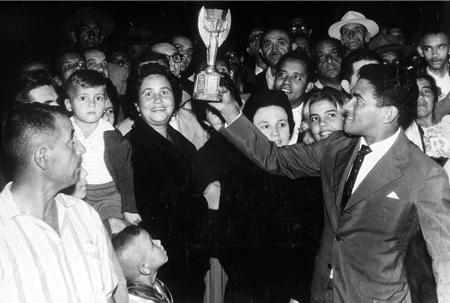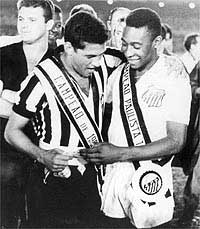This section by Quentin Ybarra and James Goldberg
Edited and Updated by Halsey Friedel in 2013
http://www.youtube.com/watch?v=JeYyx87NWrU
The unique foot skill of El Garrincha
Biography
Manuel dos Santos was born on the 28th of October 1933 in Pau Grande, Brazil. The future soccer star and master of the art of dribbling came into this world with “a left leg that bent out and a right leg that bent in, as if a gust of wind had blown them out of position.”[1] Eduardo Galeano describes Garrincha’s physical attributes from the eyes of the doctors in his town: “[the doctors] predicted this misshapen survivor of hunger and polio, dumb and lame, with the brain of an infant, a spinal column like an S and both legs bowed to the same side, would never be an athlete.”[2] Yet, Garrincha became more than an athlete. In a society that treasured the lower half of the body – as seen in dance (the samba) and martial arts (capoeira) – and a sport focused on the legs, Garrincha (the nickname given to him meaning the little wren) ironically became a national symbol of joyful, beautiful and creative play.
Garrincha grew up in a poor factory town far from the metropolitan city of Rio de Janeiro. His upbringing centered around work, soccer and exploring: “Garrincha embodied the habitus of a factory worker deriving the utmost pleasure from the marginal activities of a company town – hunting, fishing, playing as a worker-player for the factory team, dribbling around the work routine.”[3] As he became a better player and more well known, his trademark dribbling skills were noticed by the club team Botafogo and eventually the Brazilian national team. Garrincha’s love for the game, and the Brazilian public’s ultimate love for him, came from this dribbling style.
People hadn’t yet realized that Garrincha was the most amateur footballer professional football would ever produce. Or that for him, the joy of playing didn’t come with scoring goals, or winning games or even making money. Goals, victories, win bonuses – they were all just the inevitable products of the business of football. For Garrincha, the fun was in dribbling. Just dribbling.[4]
He would transfer this “hedonistic pleasure to the professional football context”[5] and inspire fans with his incredible foot skill. When Garrincha was 19 years old, he unwillingly went to a tryout with the Botafogo team. As a young man, still a teenager, he showed his skills by dribbling the ball around and even between the legs of the national team member and star, Nilton Santos. Santos was both extremely impressed and obviously intimidated as he immediately asked for Garrincha to be hired, for he did not ever want to have to face him as an opponent on any other team.[6]
In Garrincha’s professional debut he scored three goals. Although he probably could have been one of the best regardless of position, he only played one, outside right, and he always played with the same strategy. This happened for one simple reason, no one could stop him. Coaches and teams tried many different strategies to keep Garrincha at bay, but failed to change his style of play or limit his dribbles. Garrincha’s legacy began very early in his career as he loved to fool defenders with his skillful technique and sometimes taunting. Because of his skill, arrogance, and joy for the game, people loved to watch him. His quick accelerations and uncanny dribbling skills earned him the name of the most skilled dribbler the game has ever seen.[7] Garrincha is credited with being the player to teach the crowd to laugh during the game. He would pull stunts such as passing up an open goal in order to keep the ball and keep dribbling, only to dribble past the defender again and score.
Garrincha was selected for the National team in the 1958 World Cup held in Sweden. He did not play in the first two games, but started the third. The opening three minutes of Garrincha’s international career are considered to be the best three minutes of Brazilian football history. In the opening 45 seconds Garrincha dribbled past defenders and hit the post, rebounding and setting a shot up for Pele. With a tone of dominance set early, Brazil continued to control the game. His first match ended in a 3-0 victory for Brazil. Throughout the rest of his first international tournament Garrincha continued to show his footwork and dribbling skills, setting up the first two goals of the Final. Garrincha’s performance in 1958 was impressive enough to earn him a spot on the Elite XI of the World Cup, his first world cup.
In 1962 Brazil took almost the same team into international play, this time to Chile. Pele was sidelined for the majority of the tournament, putting more pressure and spotlight on the “Angel with bent leg.”[8] Garrincha was so vital and crucial in Brazilian hopes for a repeat that after he was ejected from the semi final, the referee who made the call curiously decided to leave Chile the following morning. The exact reason for this is still uncertain, but an assumption that many threats were directed toward the official would not be too implausible. The President of Peru intervened with the World Cup officials, pleading them to not punish Garrincha so that he would be allowed to play in the final. After being readmitted to the team, Brazil pulled out the victory despite their leader playing with a severe 102° fever. Garrincha’s four goals throughout the tournament were enough to tie him for the lead, and received the recognition of Player of the Tournament. Headlines in El Mercurio read, “What planet is Garrincha from?” expressing the utter awe felt by fans around the entire world as games were globally televised.[9] This was the prime of Garrincha’s career; “With Pelé and Garrincha playing together, the national team never lost a match”[10] winning two World Cups along the way in 1958 and 1962.
Career Stats
Senior career: Domestic League only
| Year |
Team |
Games (Goals) |
| 1953-65 | Botagofo | 581 (232) |
| 1966 | Corinthians | 10 (2) |
| 1967 | Portuguesa Carioca | 0 (0) |
| 1968 | Atletico Junior | 1 (0) |
| 1968-69 | Flamengo | 15 (4) |
| 1972 | Olaria | 10 (1) |
Be sure to check out the sub-pages on Garrincha:
[1] Ruy Castro, Garrincha: The Triumph and Tragedy of Brazil’s Forgotten Footballing Hero (London: Yellow Jersey, 2004), p 17.
[2] Galeano, Soccer in Sun and Shadow, p 104.
[3] Jose Sergio Leite Lopes, “Class, Ethnicity, and Color in the Making of Brazilian Football,” Daedalus, Brazil: The Burden of the past; The Promise of the Future (MIT Press, 2000), p 261.
[4] Castro, Garrincha, p 45.
[5] Lopes, “Class, Ethnicity, and Color in the Making of Brazilian Football,” p 261.
[6] Lopes, José Sergio L. “”The People’s Joy” Vanishes: Considerations on the Death of a Soccer Player.” Journal of Latin American Anthropology 4.2 (2008): 78-105.
[7] Lakasing, Dr. Edin. “Football and Alcohol? A short diary of a long and complex relationship.” London Journal of Primary Care (2009): 1-3.
[8] Bello, Futebol, 95-103.
[9] Galeano, Eduardo H. Soccer In Sun and Shadow. London: Verso, 1998: 100-115.
[10] Bellos, The Brazilian Way of Life, p 101.
Image 1 courtesy: http://www.v-brazil.com/culture/sports/world-cup/garrincha-1962.jpg
Image 2 courtesy: http://www1.folha.uol.com.br/folha/especial/2002/regionais/rio_sp-historia.shtml


